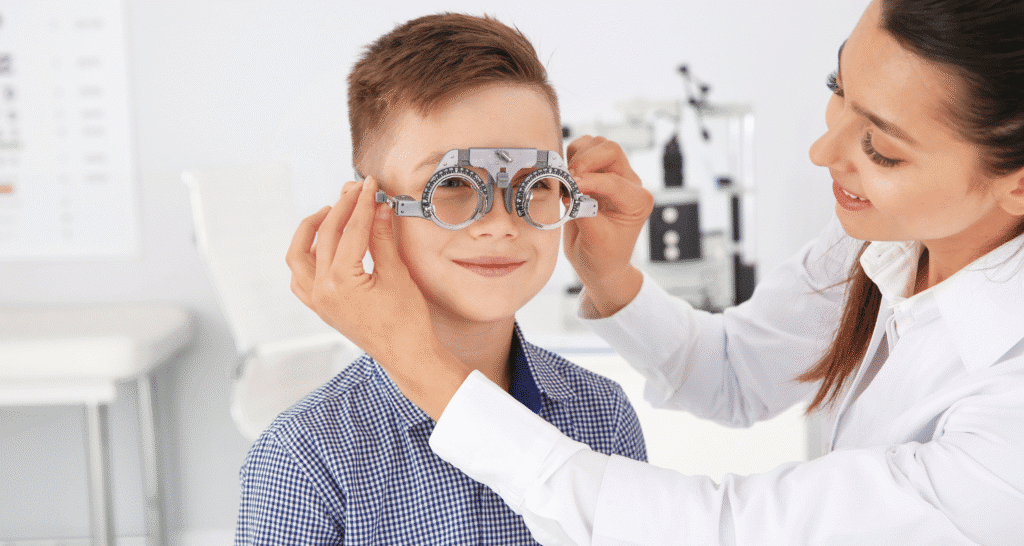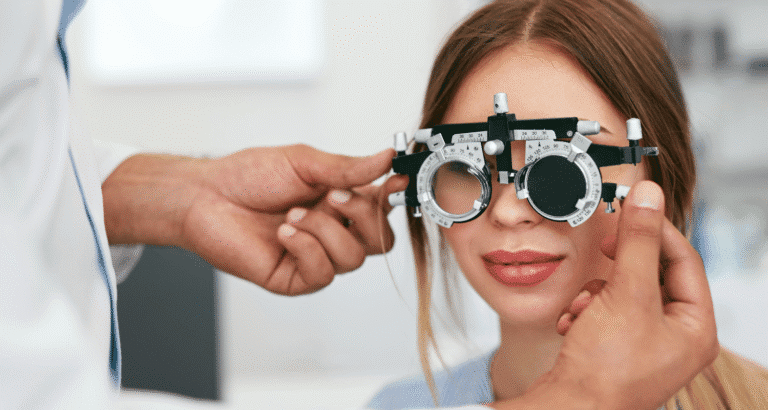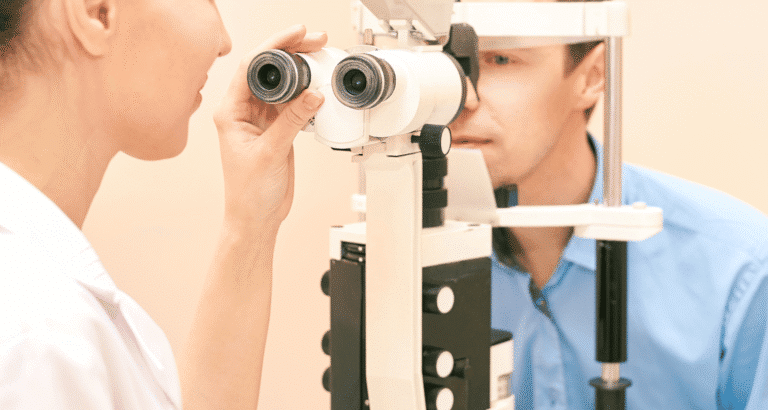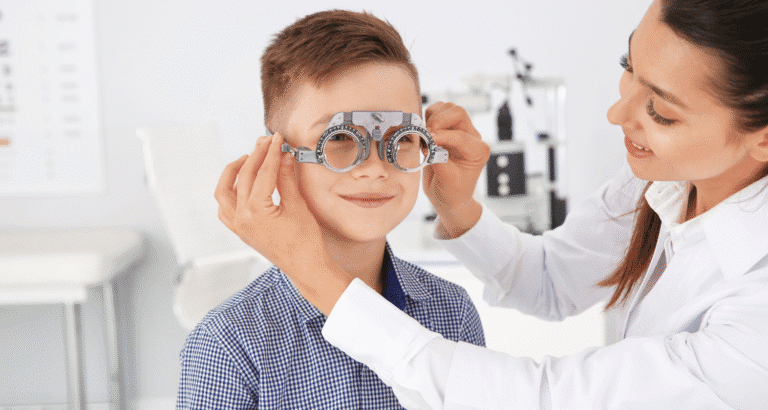Your children’s vision shapes how they learn, play, and grow. Many kids live with vision problems without knowing it. They think everyone sees the same way they do. This can affect their success in school and their confidence in sports and social settings.
At Barnes Talero Eyecare in Nashville, we help families catch children’s vision problems early. Our bilingual team provides thorough pediatric eye exams in English and Spanish. Dr. Maria Barnes brings over 40 years of experience treating children’s eye conditions. We make sure every child gets the care they need to see clearly and learn well.
Ready to schedule your child’s eye exam? Call us at (615) 485-6251 or visit our office at 390 Harding Place, Suite 104, Nashville, TN 37211.
Why Early Eye Care Matters for Children
A child’s visual system develops rapidly in the first few years of life. The brain learns to process what the eyes see. If one eye sends unclear images, the brain may ignore it. This can lead to permanent vision loss if not caught early.
Vision affects more than just seeing clearly. It impacts how children learn to read, write, and interact with the world. Kids with untreated vision problems often struggle in school. They may avoid reading or homework. Some get labeled as slow learners when they simply can’t see the board or their books properly.
Early detection makes treatment easier and more effective. Many childhood vision conditions respond well when caught before age 7 or 8. After that, the visual system becomes less flexible. The good news? Regular eye exams help catch problems before they impact your child’s life.
Most Common Children’s Vision Problems
Refractive Errors: Myopia, Hyperopia, Astigmatism
These are the most common vision issues in kids. Myopia means your child is nearsighted. They can see close objects clearly but struggle with things far away. The classroom board looks fuzzy.
Hyperopia is farsightedness. Close-up work becomes hard. Reading causes eye strain and headaches. Many young children have mild hyperopia that improves as they grow. But severe cases need glasses.
Astigmatism makes everything look blurry at all distances. The cornea has an irregular shape. Light doesn’t focus properly on the retina. Glasses or special contact lenses correct this easily.
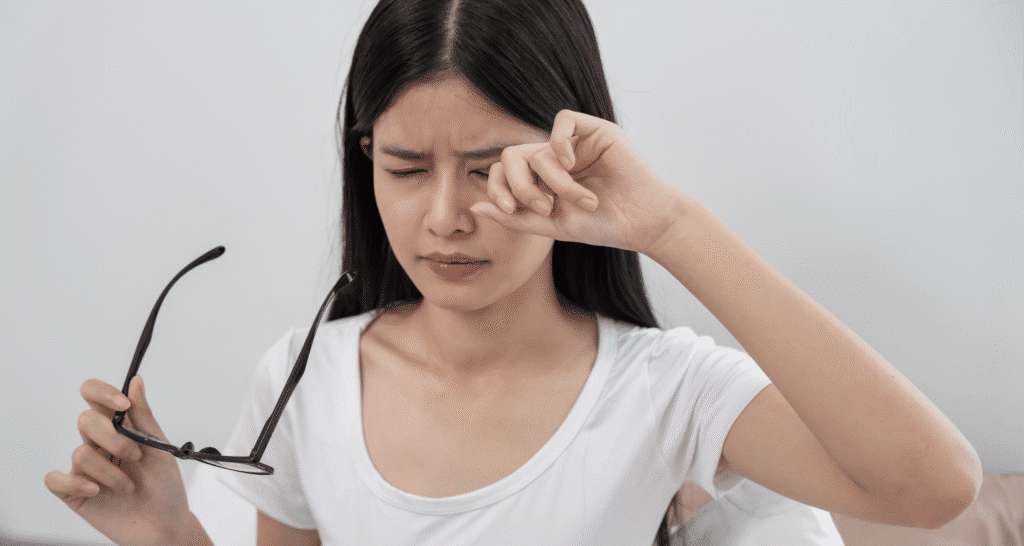
Amblyopia (Lazy Eye): Causes & Treatments
Amblyopia happens when one eye develops weaker vision than the other. The brain starts favoring the stronger eye and ignores signals from the weaker one. About 2-3% of children have this condition.
Several factors cause amblyopia:
- A big difference in prescription between the two eyes
- Strabismus (eye misalignment)
- A droopy eyelid blocking vision
- Clouding of the eye’s lens
Treatment works best before age 7. We may prescribe glasses, use eye patches to strengthen the weak eye, or recommend vision therapy.
Strabismus (Crossed Eyes): Why It Matters
Strabismus means the eyes don’t line up properly. One eye may turn in, out, up, or down while the other looks straight ahead. This isn’t just a cosmetic issue. When eyes don’t work together, the brain receives two different images. This can cause double vision or lead to amblyopia.
Some children are born with strabismus. Others develop it later. It may come and go or be constant. Treatment depends on the cause and severity. Options include glasses, vision therapy, eye patches, or in some cases, surgery.
Vision Tracking and Focus Problems
Some children have trouble moving their eyes smoothly across a page. This makes reading slow and tiring. They lose their place often or skip lines. Others struggle to focus when switching between near and far objects. Looking from the board to their notebook becomes difficult.
These problems affect learning but often go unnoticed in basic vision screenings. A comprehensive eye exam reveals these issues. Vision therapy can train the eyes to work more efficiently.
Warning Signs of Vision Problems in Children
Children rarely complain about poor vision. They don’t know what normal vision looks like. Parents and teachers need to watch for these signs:
Physical symptoms:
- Squinting frequently
- Tilting head to one side
- Covering or rubbing one eye
- Sitting very close to the TV
- Holding books close to the face
Behavioral signs:
- Avoiding reading or homework
- Short attention span with visual tasks
- Complaints of headaches, especially after reading
- Getting frustrated with schoolwork
- Poor hand-eye coordination
Academic struggles:
- Difficulty reading or slow reading speed
- Poor reading comprehension despite good listening skills
- Reversing letters or numbers
- Trouble copying from the board
- Declining grades without clear reason
If you notice any of these signs, schedule an eye exam. Even if your child passed a school vision screening, they may still have a problem. School screenings only check basic distance vision. They miss many conditions that affect learning.
How Vision Problems Affect Learning
Reading requires complex visual skills. Eyes must move smoothly across lines of text. They need to team together precisely. Focus must shift quickly between words at different distances. When these skills are weak, reading becomes exhausting.
A child with vision problems may:
- Read slowly and lose comprehension
- Skip words or reread the same line
- Use a finger to track words
- Avoid reading for pleasure
- Have messy handwriting
- Struggle with math problems on worksheets
Teachers sometimes mistake vision problems for learning disabilities or attention issues. The child seems bright but underperforms. They get distracted during reading time. They rush through visual tasks to avoid discomfort.
Vision therapy addresses these problems at their source. We strengthen eye muscles, improve focus flexibility, and train eyes to work as a team. Many children show dramatic improvement in reading and schoolwork after therapy.
Pediatric Eye Exams at Barnes Talero Eyecare
Children should have their first comprehensive eye exam at 6 months old. The next exam should happen at age 3, then again before starting kindergarten. After that, yearly exams help catch any changes.
What to Expect During a Child’s Eye Exam
We make eye exams comfortable and fun for kids. Dr. Barnes uses age-appropriate techniques. Young children don’t need to know letters to have their vision tested. We use pictures, shapes, and games to check their eyesight.
The exam includes:
- Checking how each eye sees at different distances
- Testing how well eyes work together
- Looking for signs of eye diseases
- Checking eye movement and focusing ability
- Examining the health of eye structures
- Measuring eye alignment and depth perception
Vision Therapy for Children
Vision therapy is like physical therapy for the eyes and brain. It treats problems with eye movement, focusing, and coordination. This isn’t about strengthening eye muscles for better vision. It’s about training the visual system to work more efficiently.
Who Benefits from Vision Therapy?
Children with these conditions often benefit:
- Amblyopia (lazy eye)
- Strabismus (eye turn)
- Convergence problems (eyes don’t aim together)
- Tracking difficulties (trouble following lines of text)
- Focus problems (can’t switch between near and far quickly)
- Vision-related learning difficulties
Our Approach to Vision Therapy
Dr. Barnes creates custom therapy programs for each child. Treatment combines in-office sessions with home exercises. Activities might include:
- Using special lenses or prisms
- Computer-based eye training games
- Balance and coordination exercises
- Reading activities with specific techniques
- Eye-hand coordination tasks
Therapy typically runs 12-24 weeks. We track progress carefully and adjust the program as needed. Many families see improvements in reading, sports performance, and school behavior.
Parents love that we offer this service in Nashville. Most optometry practices don’t provide vision therapy. Families usually drive to specialized centers in other cities. We bring this expert care right to your neighborhood.
Glasses and Contacts for Kids
Finding Frames Kids Actually Want to Wear
Getting children to wear glasses can be challenging. We carry frames designed for kids. They’re durable, comfortable, and come in styles children love. Letting your child pick their frames increases the chance they’ll wear them proudly.
We fit glasses properly so they stay in place during active play. Lenses include scratch-resistant coating because kids are tough on eyewear. We also offer sports straps for extra security during games and recess.
Contact Lenses for Active Children
Many parents wonder if their child is old enough for contacts. There’s no magic age. Maturity and responsibility matter more. Some 8-year-olds handle contacts beautifully. Some teenagers struggle.
We offer contact lens fittings for children ready for the responsibility. Options include:
- Daily disposable lenses (easiest care routine)
- Soft lenses for astigmatism
- Specialty lenses for hard-to-fit eyes
- Orthokeratology lenses worn at night to reshape the cornea
Sports-active kids often prefer contacts. They don’t fog up or fall off during games. We teach proper insertion, removal, and cleaning. Both parent and child learn the full care routine before taking lenses home.
Schedule your child’s eye exam today:
- Call: (615) 485-6251
- Visit: 390 Harding Place, Suite 104, Nashville, TN 37211
- We offer appointments in English and Spanish

